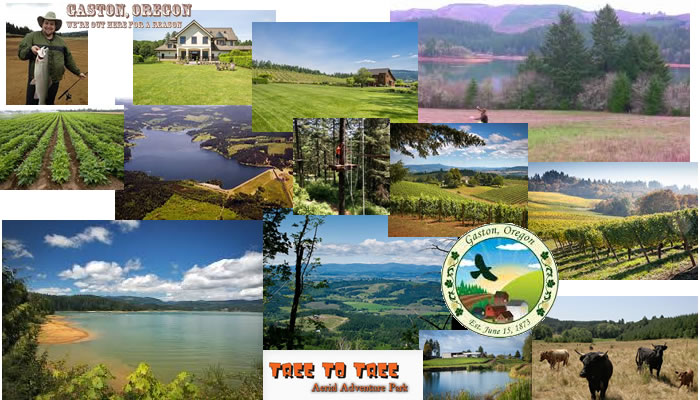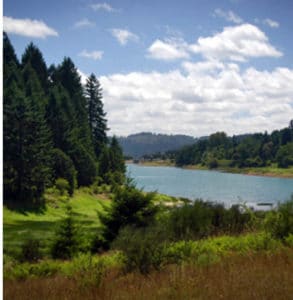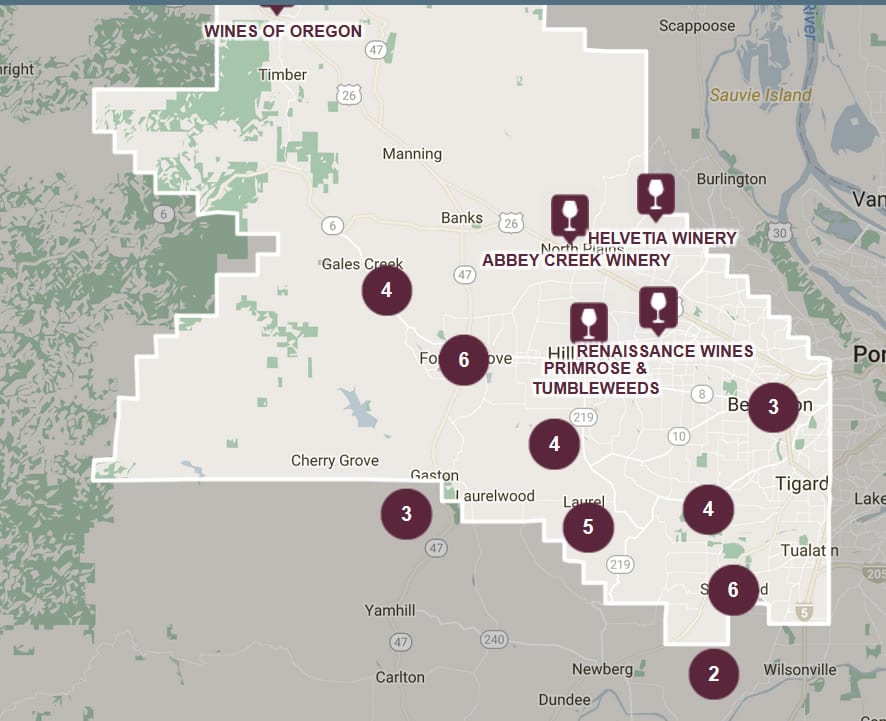Gaston Oregon is what I consider way out in the country! I have included it both in SW Suburbs and SW Countryside, since I think it fits both!

There are no real towns by it, just a tiny little country town with a few businesses in it. It is a little old farming town way up in the hills- off by itself. The land around it is really pretty- fields and woods and rolling hills. It is about an hour from Portland- and you can go south to the Newberg or McMinnville area too pretty easily, so if you work in McMinnville, it is a good commute. In the 1860s, the census recorded only about 70 people in the Gaston area. Nonetheless, in 1866, the first Gaston School was founded! So Gaston is historic, and it goes way back!

Hagg Lake, Gaston
There are lots of farmers, and lots of wineries, in fact when I printed up a list, there were 9 or 10 wineries just in Gaston, some I have included below under wineries. The countryside is absolutely gorgeous, with rolling hills and sweeping views of the valleys. I love the beauty of the countryside. It is some of the most gorgeous, breath taking scenery I have ever seen. When you drive up into the hills, especially in the spring, you are met with a patchwork quilt of reds and greens and yellows and browns. I had never seen anything like it. I don’t think you could find anything prettier in Tuscany or anywhere else! Hagg Lake is also in Gaston., maybe that is why the little town sprang up. We used to have a boat, and 5 kids, so we went up there quite a bit. It is really pretty, but doesn’t have a lot of access to the lake. There are lots of shallow areas with mud, but once you get out into the lake, it is awesome! It is actually a huge man-made lake that is really a reservoir. Most people go there to fish, but we pulled the kids in inner tubes and even did a bit of water skiing! It is located just 25 miles southwest of Portland near Forest Grove, rests in the foothills of Oregon’s Coast Range and offers a wide variety of recreational activities. Maintained and operated by Washington County, the park features numerous picnic areas, two boat ramps, a fully-stocked lake for fishing, more than 15 miles of hiking and biking trails and observation decks for wildlife and bird watching.
is also in Gaston., maybe that is why the little town sprang up. We used to have a boat, and 5 kids, so we went up there quite a bit. It is really pretty, but doesn’t have a lot of access to the lake. There are lots of shallow areas with mud, but once you get out into the lake, it is awesome! It is actually a huge man-made lake that is really a reservoir. Most people go there to fish, but we pulled the kids in inner tubes and even did a bit of water skiing! It is located just 25 miles southwest of Portland near Forest Grove, rests in the foothills of Oregon’s Coast Range and offers a wide variety of recreational activities. Maintained and operated by Washington County, the park features numerous picnic areas, two boat ramps, a fully-stocked lake for fishing, more than 15 miles of hiking and biking trails and observation decks for wildlife and bird watching.
 There is a kind of cool thing to do in Gaston Oregon. It is called Tree to Tree Adventure Park. You can climb up into the canopy of the huge trees, and walk, climb or cable between them. It sounds pretty unique!
There is a kind of cool thing to do in Gaston Oregon. It is called Tree to Tree Adventure Park. You can climb up into the canopy of the huge trees, and walk, climb or cable between them. It sounds pretty unique!
Gaston Oregon was named for Joseph Gaston, who immigrated to Oregon from Ohio in 1862 and actively promoted the west-side railroad southwest of Portland, which was later built by Holladay and Villard. He built the narrow-gauge line from Dayton to Sheridan in 1878 and subsequently wrote and published histories of Portland and of Oregon. Gaston died July 20, 1913, aged 79 years. Gaston post office was established on June 5, 1873
The growing popularity of Portland and the Pacific Northwest in general has led to population growth throughout the region. Though too far from Portland to benefit much at first, recently Gaston has started to see new housing and an uptick in school registrations. The 1990s brought a new fire station and baseball/softball-oriented park. Just after 2000, a new post office was built on the edge of town. Thus far, the town has not been able to effectively capitalize on the local wine industry’s growing national and international recognition. In 2006, the mayoral candidate advocated obtaining state or federal funding to revitalize the commercial strip on Main Street which, in theory, could help the city capture some of the wine tourism dollars.
History and Wineries of Gaston Oregon
Here is the little bit of history I could find. Gaston Oregon was named for Joseph Gaston, who immigrated to Oregon from Ohio in 1862 and actively promoted the west-side railroad southwest of Portland, which was later built by Holladay and Villard. He built the narrow-gauge line from Dayton to Sheridan in 1878 and subsequently wrote and published histories of Portland and of Oregon. Gaston died July 20, 1913, aged 79 years. The Gaston post office was established on June 5, 1873. d
There really isn’t too much to say about it except the beautiful farmland, the wineries and Hagg Lake!
There are wineries all around Gaston Oregon. Here are some of the ones you can find there:

Patton Valley Vineyards, Elven Glade Vineyard, ADEA Wine Co, Cancilla Cellars, Elk Grove Winery, Thistle Wines, Elk Cove Vineyard, Kramer Vineyards, Plum Hill Vineyards, and Big Table Farm




History of Gaston Oregon
History
Prior to the arrival of European immigrants in the 1800s, little is known about Native American settlements in the Gaston area. What is known indicates that Native Americans in the area lived similarly to other Pacific Northwest tribes. In nearby Cherry Grove there are a few petroglyphs usually credited to the Atfalati tribe, which is a division of Kalapuya. Like many other indigenous peoples in North America, it is thought as many as 90% of the local population were killed by smallpox, malaria, influenza or other European diseases even before the area began to feel the presence of significant European settlement.
In the 1860s, the census recorded only about 70 people in the Gaston area. Nonetheless, in 1866, the first Gaston School was founded. In 1870, a new school was built near the connecting road between Old Highway 47 and the new Highway 47. Initially students only attended school for 3-6 months per year, later expanded to 9 months. In 1871, as a stage coach line brought more settlers, and in anticipation of a new rail line, railroad developer and town namesake Joseph Gaston set aside 2 acres of land on what was then the edge of town for a school.
In the early 1870s, stagecoach and rail service was expanding rapidly in Washington County. By 1872, a stop on the Portland-St. Joseph line in Patton Valley was officially named Gaston. With a train stop, more people came and by 1873 a post office opened in the new town. The same year, the first church, Gaston Congregational Church, was also built. In the 1880s, Joseph Gaston was responsible for draining Wapato Lake, which lay in the valley around the rail stop, creating the farmland that exists today. “Wapato” is a word from the local Indians that refers to a water-based starchy root vegetable related to arrowroot sometimes called a “water potato” in local English.
The addition of a spur line to the nearby Cherry Grove area for the construction of a lumber mill in 1911 added significant activity to the local economy, although it had to be shut in 1913 during a lumber market crash. The crash of 1913 notwithstanding, by 1916 Gaston had added a bank, J.H. Wescott and Sons General Merchandise, Bell & Owens General Mercantile Company, and other businesses.
In 1915 a new high school was built on the land Joseph Gaston had previously set aside for a school. That high school was in use through the 1987-1988 school years, when it was condemned. The condemning of the building became a crucial local issue for the town, with residents split between merging with a nearby district (both Forest Grove and Yamhill were considered), and building a new high school. In the end, a new high school was built and Gaston retained its independent school system and with it a degree of local pride. Currently the Gaston School District is a full K-12 district, with several hundred students total.
See and Do
Hagg Lake: Here you can go Water Skiing, Jet Skiing, Wind surfing, Sailing, Boating, Fishing, Picnicking, Bird watching, Hiking, and Bicycling.


